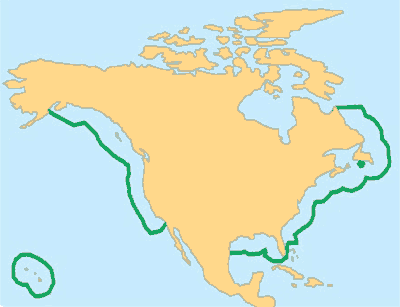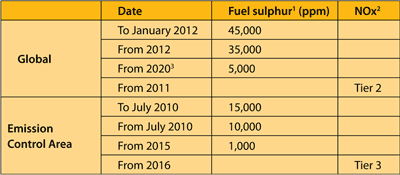The United States and Canada want ships to burn cleaner fuel when approaching the continent to reduce smog-related deaths.
On March 27 the United States and Canada jointly submitted a proposal1 to the International Maritime Organization (IMO) to designate most areas of the coastal waters covered by their Exclusive Economic Zones as an emissions control area (ECA) for the control of sulphur oxides, nitrogen oxides, and particulate matter emissions.
According to calculations by the US Environmental Protection Agency (EPA), the creation of an ECA would save up to 8,300 American and Canadian lives every year by 2020 by imposing stricter environmental standards on large ships. The use of current high-sulphur residual fuel in ships leads to large emissions of smog-inducing nitrogen oxides, healthdamaging fine particles, and sulphur dioxide which create acid rain.
Urban neighbourhoods that surround ports in the US, such as the hubs of Newark, New Jersey and Los Angeles, have typically suffered the worst health problems, such as asthma and cancer, from the pollutants, according to EPA studies. Some 40 US ports currently fail to meet federal air pollution standards.
The Canadian area most affected by marine pollution is Vancouver and lower British Colombia, the location of the country’s largest port and gateway to growing trade with Asia, but there are also sizable emissions along the St. Lawrence Seaway and the Great Lakes, and in Atlantic ports, such as Halifax and Saint John.
The two countries have a combined population in excess of 330 million, over half of whom reside along the Pacific and Atlantic coasts and in port cities. More than 100 million people in the US and Canada live in areas with air pollution at levels exceeding the national ambient air quality standards, levels which are unhealthy according to the World Health Organisation.
Because ship pollution travels great distances, much of the inland population is also affected by ship emissions and will benefit from the cleaner air made possible by applying the stricter ECA standards.
It is estimated that the creation of an ECA will save between 3,700 and 8,300 American and Canadian lives every year by 2020, and avoid some 3.4 million instances of respiratory ailments, such as asthma, according to an analysis the two countries conducted for their application.
Moreover, controlling ship emissions would help reduce air pollution related stresses, such as acidification, nitrogen nutrient loading and ground-level ozone, in a large number of sensitive ecosystems, including numerous forests, grasslands, alpine areas, wetlands, rivers, lakes, estuaries, and coastal waters. The total sulphur and nitrogen deposition in sensitive ecosystems would be significantly reduced, which will contribute to the recovery of sensitive ecosystems in both the US and Canada.

The proposed North American Emission Control Area (green line).
The proposed emissions control area extend s 200 nautical miles (370 kilometres) from the coast, and includes waters adjacent to the Pacific coast, the Atlantic/ Gulf coast and the main Hawaiian Islands (see figure). Not included are the Pacific US territories, smaller Hawaiian Islands, the Aleutian Islands and Western Alaska, the US territories of Puerto Rico and the US Virgin Islands, and the US and Canadian Arctic, but they could be included in the future after assessments are done.
Under the new programme, large ships such as oil tankers and cargo ships that operate in ECAs will face stricter emission standards designed to reduce the threat they pose to human health and the environment. These standards will cut sulphur in fuel by 98 per cent, particulate matter (PM) emissions by 85 per cent, and nitrogen oxides (NOx) emissions by 80 per cent as compared to the current global requirements.
To achieve these reductions, ships must use fuel with no more than 1,000 parts per million (ppm) sulphur beginning in 2015, and new ships must used advanced NOx emission control technologies beginning in 2016 (see table below).
Table: A summary of MARPOL Annex VI global and geographic-based international standards and their phase-in schedule, as adopted by IMO in October 2008.

1) Exhaust-gas cleaning systems (e.g. scrubbers) that achieve equivalent sulphur emission reductions may be used as an alternative to low-sulphur fuels.
2) Today’s Tier 1 NOx standards apply to ships built as from year 2000 and range from approximately 10 to 17 grams NOx/kWh, depending on engine speed. The Tier 2 standards represent a 15-20% NOx reduction below Tier 1, and the Tier 3 standards represent an 80% NOx reduction below Tier 1. These NOx standards apply only to newly built ships.
3) Subject to review in 2018, this standard could be postponed to 2025.
For ships engaged in international trade, the economic impacts of complying with the ECA standards are expected to be modest. Analysis of a ship in liner service between Singapore, Seattle, and Los Angeles/Long Beach suggests that improving from current performance to ECA standards would increase the cost of shipping a twenty-foot-equivalent container by about US$ 18. Overall, operating costs for a ship on such a route, which includes about 1,700 nautical miles of operation in the proposed ECA, would increase by about three per cent.
Similarly, the impacts on cruise vessels are expected to be small. The passenger price of a seven-day Alaska cruise operating entirely within the ECA would increase about US$ 7 per day.
The two governments estimate that the total annual cost of improving ship emissions from current performance to emissions control area standards will be US$ 3.2 billion in 2020. Approximately two-thirds of this relates to operating costs (mainly switching to more expensive low-sulphur distillate fuels), and the remaining one-third to hardware costs (primarily installation of SCR).
It is expected that in the proposed ECA, less than 16 million tonnes of fuel will be consumed in 2020, which would then be about three per cent of total global marine fuel use. Based on computer modelling analyses, the average increase in costs associated with switching from high-sulphur residual fuel to low-sulphur distillate fuel will be US$ 145 per tonne. As the distillate fuel has a five per cent higher energy content, the net equivalent cost increase is estimated at US$ 123 for each tonne of residual fuel that is replaced by distillate fuel.
The costs for each tonne of NOx, SOx, and PM avoided are estimated at US$ 2,600, US$ 1,200, and US$ 11,000, respectively. These costs per tonne are a measure of cost-effectiveness, and are comparable or favourable to the cost-effectiveness of the controls imposed on many landbased sources.
It is concluded that improving current ship emission levels to ECA standards is one of the most cost-effective measures available to obtain necessary improvements in air quality in the US and Canada.
The joint US-Canada application for ECA designation will be discussed at the 59th session of the IMO’s Marine Environment Protection Committee (MEPC 59), to be held in London 13-17 July 2009.
Assuming the application is considered here, the earliest possible approval is by the MEPC 60, which is anticipated to take place in March 2010. If accepted there, the new ECA could enter into force in August 2012.
Christer Ågren
Proposal to designate an emission control area for nitrogen oxides, sulphur oxides and particulate matter submitted by the United States and Canada. IMO MEPC 59/6/5, 2 April 2009.
More information on the US-Canada proposal is available at: www.epa.gov/otaq/oceanvessels.htm
